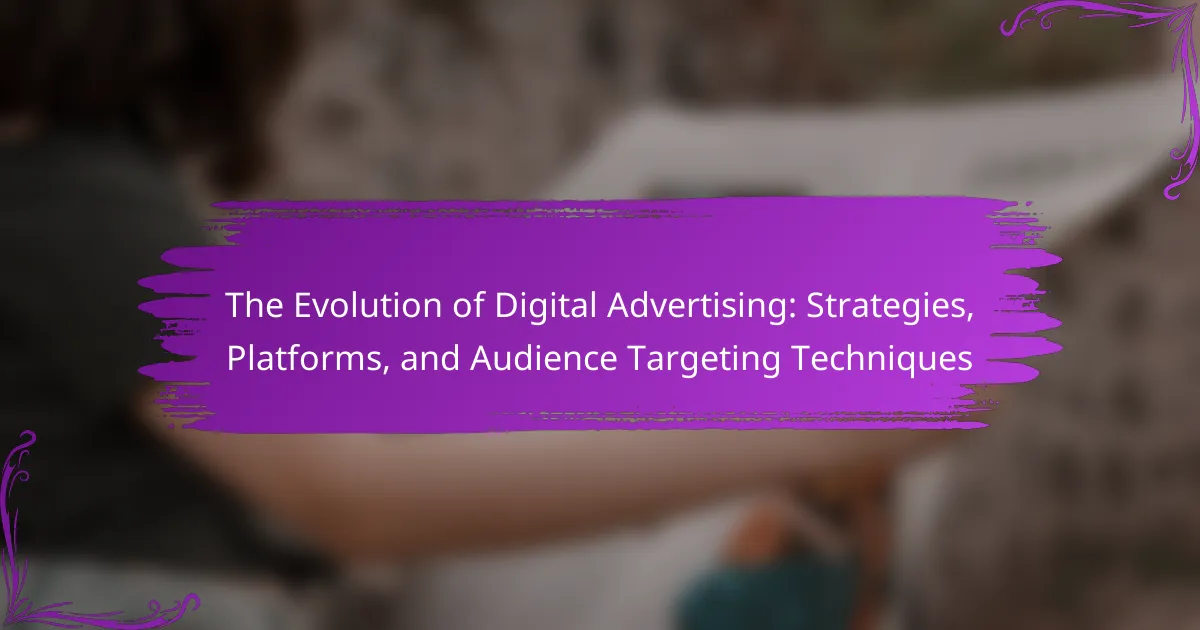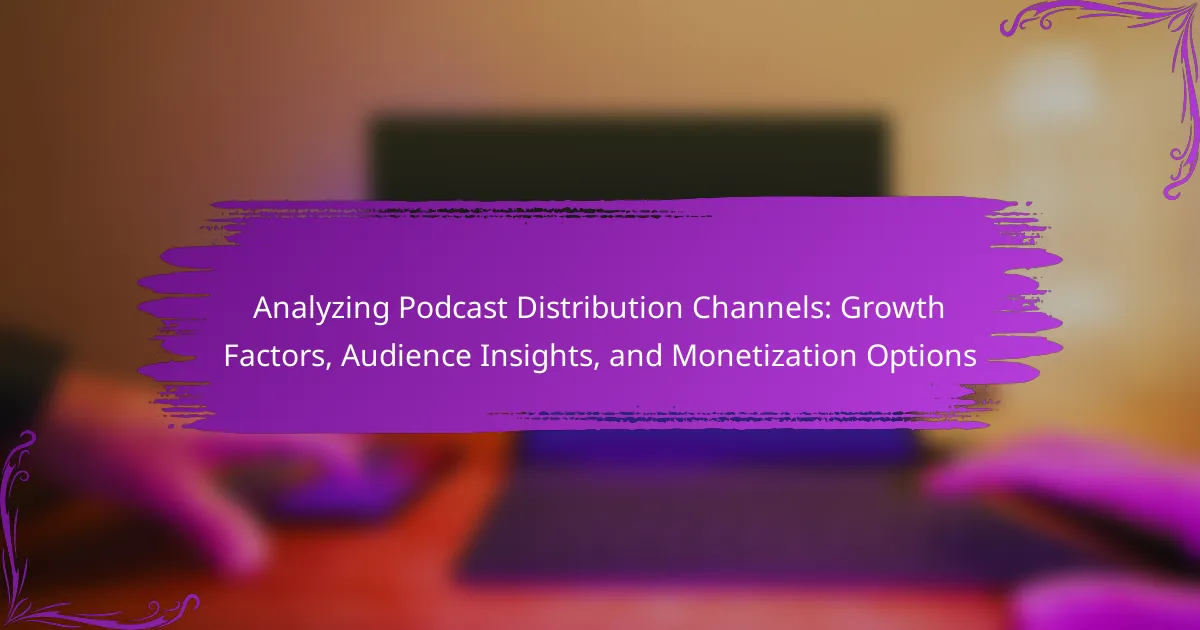
What is the Evolution of Digital Advertising?
Digital advertising has evolved significantly since its inception. It began in the 1990s with basic banner ads on websites. These early ads were static and lacked targeting capabilities. In the early 2000s, search engine marketing emerged, allowing advertisers to target users based on their search queries. This period marked the rise of pay-per-click advertising, which became a standard model.
The advent of social media in the mid-2000s transformed digital advertising. Platforms like Facebook and Twitter introduced targeted advertising based on user demographics and interests. By the 2010s, programmatic advertising gained traction. This technology allowed for automated buying and selling of ad space, enhancing efficiency and targeting precision.
Mobile advertising also became prominent as smartphone usage surged. Advertisers adapted their strategies to cater to mobile users, focusing on app-based ads and responsive designs. Today, digital advertising encompasses a variety of formats, including video ads, influencer marketing, and native advertising.
The evolution of digital advertising reflects advancements in technology and changes in consumer behavior. As of 2023, the global digital advertising market is projected to exceed $500 billion, showcasing its pivotal role in marketing strategies.
How has digital advertising transformed over the years?
Digital advertising has transformed significantly over the years. Initially, it focused on banner ads and simple text links. As technology advanced, search engine marketing became prominent in the early 2000s. Social media platforms emerged, revolutionizing how brands connect with audiences. Mobile advertising gained traction with the rise of smartphones. Data analytics improved targeting capabilities, allowing for personalized ads. Video advertising surged in popularity, driven by platforms like YouTube. Programmatic advertising automated buying processes, increasing efficiency. These changes reflect the industry’s adaptation to consumer behavior and technological advancements.
What were the key milestones in the evolution of digital advertising?
The key milestones in the evolution of digital advertising include the launch of the first banner ad in 1994. This ad marked the beginning of online advertising as we know it. In 1998, Google introduced AdWords, allowing businesses to target ads based on keywords. This innovation transformed how advertisers reached audiences.
In 2004, social media platforms like Facebook emerged, enabling targeted advertising based on user demographics and interests. The introduction of programmatic advertising in 2010 automated the buying and selling of ad space, increasing efficiency.
Mobile advertising gained prominence in 2012 with the rise of smartphones, allowing ads to reach consumers on the go. In 2016, the use of artificial intelligence in advertising began to optimize ad placements and targeting.
These milestones reflect the rapid advancements in technology and consumer behavior that have shaped digital advertising.
How have consumer behaviors influenced the evolution of digital advertising?
Consumer behaviors have significantly influenced the evolution of digital advertising. As consumers increasingly engage with online platforms, advertisers have adapted their strategies accordingly. The rise of social media has shifted focus toward personalized advertising. Consumers now expect tailored content that resonates with their preferences. Data analytics has become essential in understanding consumer habits. Advertisers utilize this data to optimize their campaigns in real-time. The demand for transparency has also grown, prompting brands to adopt more authentic messaging. Ultimately, these consumer-driven changes have reshaped the landscape of digital advertising.
What are the primary strategies in digital advertising?
The primary strategies in digital advertising include search engine marketing, social media marketing, content marketing, email marketing, and display advertising. Search engine marketing focuses on increasing visibility in search engine results through paid ads and optimization techniques. Social media marketing utilizes platforms like Facebook and Instagram to engage users and promote brands. Content marketing involves creating valuable content to attract and retain a target audience. Email marketing targets consumers directly through personalized messages and promotions. Display advertising uses visual ads on websites to capture user attention. Each strategy leverages specific platforms and techniques to maximize reach and effectiveness.
How do different strategies address various market needs?
Different strategies address various market needs by tailoring approaches to specific consumer demands. For example, content marketing focuses on providing valuable information to engage audiences. This strategy meets the need for informative content in a saturated market. Social media advertising targets specific demographics, addressing the need for personalized marketing. Data analytics helps identify trends, allowing for responsive adjustments to strategies. Email marketing segments audiences to deliver tailored messages, fulfilling the need for direct communication. Each strategy aligns with market needs through targeted messaging and audience understanding. These approaches enhance customer satisfaction and drive brand loyalty.
What role does data play in shaping digital advertising strategies?
Data plays a crucial role in shaping digital advertising strategies. It enables advertisers to understand consumer behavior and preferences. By analyzing data, businesses can segment their audience effectively. This segmentation allows for targeted messaging that resonates with specific groups. Data also informs the selection of advertising platforms. Advertisers can choose channels that align with their audience’s online presence. Furthermore, data facilitates real-time adjustments to campaigns. This adaptability enhances the effectiveness of advertising efforts. According to a 2020 report by eMarketer, 70% of marketers use data analytics to refine their strategies. This statistic underscores the importance of data in optimizing digital advertising.

What platforms are used in digital advertising?
Digital advertising utilizes various platforms to reach audiences effectively. Key platforms include social media networks like Facebook, Instagram, and Twitter. Search engines such as Google and Bing also play a significant role. Display advertising networks, including Google Display Network, enable visual ads across websites. Video platforms like YouTube are essential for video advertising. E-commerce sites, such as Amazon, offer targeted advertising options. Mobile advertising platforms, including in-app ads, reach users on their devices. Programmatic advertising platforms automate ad buying and placement. These platforms collectively enhance the reach and effectiveness of digital advertising campaigns.
How do social media platforms impact digital advertising?
Social media platforms significantly enhance digital advertising effectiveness. They provide targeted advertising options based on user demographics and behaviors. Advertisers can reach specific audiences more efficiently. For instance, Facebook’s advertising reach exceeds 2.9 billion monthly active users. This vast user base allows for precise targeting and higher engagement rates. Additionally, social media facilitates real-time interaction between brands and consumers. This interaction fosters brand loyalty and customer feedback. Studies show that ads on social media generate higher conversion rates compared to traditional digital ads. Therefore, social media platforms are crucial in shaping modern digital advertising strategies.
What are the most effective social media platforms for advertising?
The most effective social media platforms for advertising are Facebook, Instagram, LinkedIn, and TikTok. Facebook offers extensive targeting options and a large user base, making it ideal for various demographics. Instagram, owned by Facebook, excels in visual content and engages younger audiences effectively. LinkedIn is the top choice for B2B advertising, reaching professionals and decision-makers. TikTok has rapidly gained popularity, particularly among Gen Z, with its short-form video content driving high engagement rates. According to Statista, Facebook had over 2.8 billion monthly active users in 2021, emphasizing its reach. Instagram’s engagement rates are significantly higher than other platforms, making it a valuable advertising tool. LinkedIn reports that 92% of B2B marketers use it for advertising, showcasing its effectiveness in the professional sphere. TikTok’s user engagement is also noteworthy, with users spending an average of 52 minutes per day on the app.
How do algorithms on social media platforms affect ad visibility?
Algorithms on social media platforms significantly influence ad visibility. They determine which ads users see based on engagement metrics and user behavior. For example, algorithms prioritize content that matches a user’s interests and interactions. This means ads that resonate with users’ preferences are more likely to be displayed. Additionally, algorithms analyze user data to optimize ad placements in real-time. According to a study by the Pew Research Center, 64% of users feel that social media algorithms shape their online experience, including ads. Therefore, effective targeting strategies are crucial for maximizing ad visibility.
What role do search engines play in digital advertising?
Search engines are crucial in digital advertising as they facilitate targeted ad placements. They connect advertisers with users actively searching for specific products or services. Search engines utilize algorithms to display relevant ads based on user queries. This targeted approach increases the likelihood of conversions. In 2022, Google Ads generated over $224 billion in revenue, showcasing the effectiveness of search engine advertising. Advertisers bid on keywords to secure ad placements, allowing for budget control and performance tracking. Search engines also provide analytics tools to measure ad effectiveness and optimize campaigns.
How does search engine optimization enhance digital advertising effectiveness?
Search engine optimization (SEO) enhances digital advertising effectiveness by improving website visibility and organic traffic. Higher visibility leads to increased click-through rates on ads. SEO targets specific keywords that align with user intent. This alignment ensures that ads reach a more relevant audience. Improved website performance also boosts user experience, leading to higher conversion rates. According to a study by HubSpot, 61% of marketers say improving SEO and growing their organic presence is their top inbound marketing priority. Thus, effective SEO strategies contribute significantly to the overall success of digital advertising campaigns.
What are the differences between paid search and organic search advertising?
Paid search advertising involves paying for ad placements on search engine results pages (SERPs). Advertisers bid on keywords to display their ads prominently. Organic search advertising, on the other hand, focuses on optimizing website content for better visibility without direct payment. It relies on search engine optimization (SEO) techniques to improve rankings.
Paid search provides immediate visibility and traffic, while organic search builds authority over time. According to a study by WordStream, paid search ads can yield a 200% ROI, while organic search leads have a 14.6% close rate compared to 1.7% for paid leads. This highlights the effectiveness of both strategies in different contexts.

What audience targeting techniques are utilized in digital advertising?
Audience targeting techniques in digital advertising include demographic targeting, interest-based targeting, behavioral targeting, geographic targeting, and retargeting. Demographic targeting focuses on age, gender, and income levels. Interest-based targeting utilizes user interests and hobbies for ad placement. Behavioral targeting analyzes user behavior and online activity to serve relevant ads. Geographic targeting considers the user’s location to deliver localized content. Retargeting aims at users who previously interacted with a brand, encouraging them to return. These techniques enhance ad relevance and effectiveness, leading to improved engagement and conversion rates.
How do demographic factors influence audience targeting?
Demographic factors significantly influence audience targeting by allowing marketers to tailor their strategies to specific groups. These factors include age, gender, income, education, and location. For instance, younger demographics may respond better to social media campaigns, while older audiences might prefer traditional media. Income levels can determine purchasing power and product preferences. Education influences the complexity of messaging required for effective communication. Geographic location helps in localizing content and offers. According to a study by Pew Research, targeted advertising based on demographics can increase engagement rates by up to 50%. This data underscores the importance of understanding demographic factors in optimizing audience targeting strategies.
What are the most common demographic segments targeted in digital advertising?
The most common demographic segments targeted in digital advertising include age, gender, income, and education level. Age segments often range from millennials to baby boomers, each with distinct preferences. Gender targeting allows advertisers to tailor messages for men or women based on purchasing behavior. Income segmentation helps brands reach consumers within specific economic brackets, influencing product offerings. Education level targeting focuses on individuals with varying degrees of education, impacting content complexity and messaging. According to a study by eMarketer, 72% of marketers use demographic data to enhance targeting effectiveness. This data-driven approach ensures that advertising resonates with the intended audience.
How can advertisers leverage demographic data for effective targeting?
Advertisers can leverage demographic data to enhance targeting precision. By analyzing age, gender, income, and location, they can tailor messages to specific audience segments. For instance, a brand selling luxury goods may target higher-income individuals. Advertisers can also use demographic data to identify trends and preferences within different groups. This approach increases engagement rates and conversion potential. Research shows that targeted advertising can boost ROI significantly, with some studies indicating up to a 300% increase in effectiveness. Thus, demographic data is essential for optimizing advertising strategies.
What are behavioral targeting techniques in digital advertising?
Behavioral targeting techniques in digital advertising involve delivering personalized ads based on users’ online behavior. These techniques analyze data from users’ browsing history, search queries, and interactions with websites. By tracking this information, advertisers can identify patterns and preferences. This allows them to create tailored ad experiences that resonate with individual users. For example, if a user frequently visits travel websites, they may see ads for flights and hotels. Research shows that behavioral targeting can increase ad engagement rates by up to 50%. This demonstrates the effectiveness of using behavioral data in digital advertising strategies.
How does tracking user behavior enhance targeting precision?
Tracking user behavior enhances targeting precision by providing detailed insights into user preferences and actions. This data allows advertisers to create personalized content that resonates with specific audiences. By analyzing patterns in browsing history, clicks, and interactions, marketers can identify which products or services are most relevant to users.
For instance, a study by eMarketer found that targeted ads based on user behavior can increase conversion rates by up to 50%. This demonstrates the effectiveness of behavior tracking in improving the relevance of advertising. Additionally, real-time data enables advertisers to adjust campaigns quickly, optimizing performance based on immediate user responses.
Overall, tracking user behavior is crucial for developing tailored marketing strategies that align with consumer interests, thus enhancing targeting precision.
What ethical considerations arise with behavioral targeting?
Ethical considerations in behavioral targeting include privacy concerns, consent issues, and potential manipulation. Behavioral targeting relies on collecting user data to create personalized advertisements. This practice raises questions about how much data is acceptable to collect. Users often remain unaware of the extent of data collection. Consent is frequently assumed rather than explicitly obtained. This can lead to feelings of distrust among consumers. Additionally, behavioral targeting can manipulate user choices by presenting ads that exploit vulnerabilities. Such practices can undermine informed decision-making. Research indicates that targeted ads can reinforce existing biases, limiting exposure to diverse viewpoints.
What best practices should be followed for effective digital advertising?
Effective digital advertising requires clear targeting, compelling content, and data analysis. Start by defining your target audience based on demographics and interests. Utilize platforms like Google Ads and Facebook Ads for precise audience segmentation. Create engaging and relevant ad content that resonates with your audience. Use A/B testing to determine which messages perform best. Monitor key performance indicators (KPIs) such as click-through rates and conversion rates. Adjust your strategies based on data insights to optimize campaign performance. Consistent evaluation and adaptation lead to improved advertising effectiveness.
How can businesses measure the success of their digital advertising campaigns?
Businesses can measure the success of their digital advertising campaigns through various key performance indicators (KPIs). These KPIs include metrics such as click-through rates (CTR), conversion rates, and return on ad spend (ROAS). CTR indicates how many users clicked on an ad compared to how many saw it. A higher CTR suggests effective ad targeting and messaging. Conversion rates show the percentage of users who completed a desired action after clicking on the ad. This metric directly reflects the ad’s effectiveness in driving user engagement. ROAS calculates the revenue generated for every dollar spent on advertising. A higher ROAS indicates a more successful campaign. Additionally, businesses can track engagement metrics like impressions, shares, and comments to assess audience interaction. Analyzing these metrics allows businesses to refine their strategies and improve future campaigns.
What are common pitfalls to avoid in digital advertising strategies?
Common pitfalls to avoid in digital advertising strategies include lack of clear objectives. Without defined goals, campaigns often lack direction. Another pitfall is neglecting audience research. Understanding the target audience is crucial for effective messaging. Failing to optimize campaigns regularly can lead to wasted budget. Continuous monitoring and adjustments are necessary for success. Ignoring data analytics can also hinder performance. Data provides insights that inform strategy improvements. Additionally, over-reliance on a single platform can limit reach. Diversifying across channels enhances visibility. Lastly, poor ad design can reduce engagement. High-quality visuals and compelling copy are essential for attracting attention.
The main entity of the article is digital advertising, which has evolved from simple banner ads in the 1990s to a complex ecosystem involving various strategies and platforms. The article outlines key milestones in this evolution, including the rise of search engine marketing, social media advertising, and programmatic buying. It also examines the impact of consumer behavior on advertising strategies, the role of data analytics in optimizing campaigns, and the effectiveness of different platforms such as Google and Facebook. Additionally, the article discusses audience targeting techniques, including demographic and behavioral targeting, and highlights best practices for measuring the success of digital advertising campaigns.



